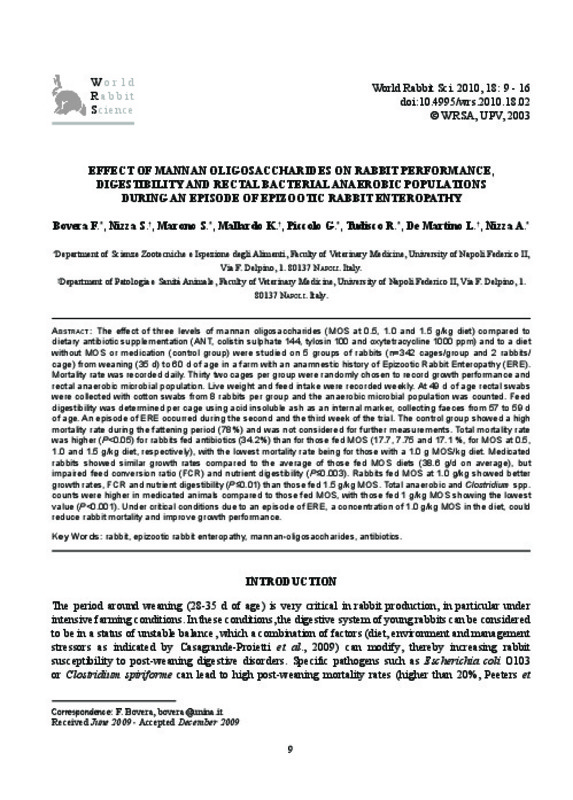JavaScript is disabled for your browser. Some features of this site may not work without it.
Buscar en RiuNet
Listar
Mi cuenta
Estadísticas
Ayuda RiuNet
Admin. UPV
Effect of mannan oligosaccharides on rabbit performance, digestibility and rectal Bacterial anaerobic populations during an episode of epizootic rabbit enteropathy
Mostrar el registro sencillo del ítem
Ficheros en el ítem
| dc.contributor.author | Bovera, F.
|
|
| dc.contributor.author | Nizza, A.
|
|
| dc.contributor.author | Marono, S.
|
|
| dc.contributor.author | Mallardo, K.
|
|
| dc.contributor.author | Piccolo, G.
|
|
| dc.contributor.author | Tudisco, R.
|
|
| dc.contributor.author | De Martino, L.
|
|
| dc.contributor.author | Nizza, S.
|
|
| dc.date.accessioned | 2010-04-13T09:34:35Z | |
| dc.date.available | 2010-04-13T09:34:35Z | |
| dc.date.issued | 2010 | |
| dc.identifier.issn | 1257-5011 | |
| dc.identifier.uri | http://hdl.handle.net/10251/7465 | |
| dc.description.abstract | [EN] The effect of three levels of mannan oligosaccharides (MOS at 0.5, 1.0 and 1.5 g/kg diet) compared to dietary antibiotic supplementation (ANT, colistin sulphate 144, tylosin 100 and oxytetracycline 1000 ppm) and to a diet without MOS or medication (control group) were studied on 5 groups of rabbits (n=342 cages/group and 2 rabbits/cage) from weaning (35 d) to 60 d of age in a farm with an anamnestic history of Epizootic Rabbit Enteropathy (ERE). Mortality rate was recorded daily. Thirty two cages per group were randomly chosen to record growth performance and rectal anaerobic microbial population. Live weight and feed intake were recorded weekly. At 49 d of age rectal swabs were collected with cotton swabs from 8 rabbits per group and the anaerobic microbial population was counted. Feed digestibility was determined per cage using acid insoluble ash as an internal marker, collecting faeces from 57 to 59 d of age. An episode of ERE occurred during the second and the third week of the trial. The control group showed a high mortality rate during the fattening period (78%) and was not considered for further measurements. Total mortality rate was higher (P<0.05) for rabbits fed antibiotics (34.2%) than for those fed MOS (17.7, 7.75 and 17.1 %, for MOS at 0.5, 1.0 and 1.5 g/kg diet, respectively), with the lowest mortality rate being for those with a 1.0 g MOS/kg diet. Medicated rabbits showed similar growth rates compared to the average of those fed MOS diets (38.6 g/d on average), but impaired feed conversion ratio (FCR) and nutrient digestibility (P<0.003). Rabbits fed MOS at 1.0 g/kg showed better growth rates, FCR and nutrient digestibility (P<0.01) than those fed 1.5 g/kg MOS. Total anaerobic and Clostridium spp. counts were higher in medicated animals compared to those fed MOS, with those fed 1 g/kg MOS showing the lowest value (P<0.001). Under critical conditions due to an episode of ERE, a concentration of 1.0 g/kg MOS in the diet, could reduce rabbit mortality and improve growth performance. | en_EN |
| dc.language | Inglés | en_EN |
| dc.publisher | World Rabbit Science. ICTA. UPV | en_EN |
| dc.relation.ispartof | World Rabbit Science | |
| dc.rights | Reserva de todos los derechos | es_ES |
| dc.subject | Rabbit | en_EN |
| dc.subject | Epizootic rabbit enteropathy | en_EN |
| dc.subject | Antibiotics | en_EN |
| dc.subject | Mannan-oligosaccharides | en_EN |
| dc.title | Effect of mannan oligosaccharides on rabbit performance, digestibility and rectal Bacterial anaerobic populations during an episode of epizootic rabbit enteropathy | en_EN |
| dc.type | Artículo | en_EN |
| dc.identifier.doi | 10.4995/wrs.2010.18.02 | en_EN |
| dc.rights.accessRights | Abierto | es_ES |
| dc.description.bibliographicCitation | Bovera, F.; Nizza, A.; Marono, S.; Mallardo, K.; Piccolo, G.; Tudisco, R.; De Martino, L.... (2010). Effect of mannan oligosaccharides on rabbit performance, digestibility and rectal Bacterial anaerobic populations during an episode of epizootic rabbit enteropathy. World Rabbit Science. 18(1):9-16. https://doi.org/10.4995/wrs.2010.18.02 | es_ES |
| dc.relation.publisherversion | https://doi.org/10.4995/wrs.2010.18.02 | es_ES |
| dc.description.upvformatpinicio | 9 | |
| dc.description.upvformatpfin | 16 | |
| dc.description.volume | 18 | |
| dc.description.issue | 1 | |
| dc.identifier.eissn | 1989-8886 | es_ES |








